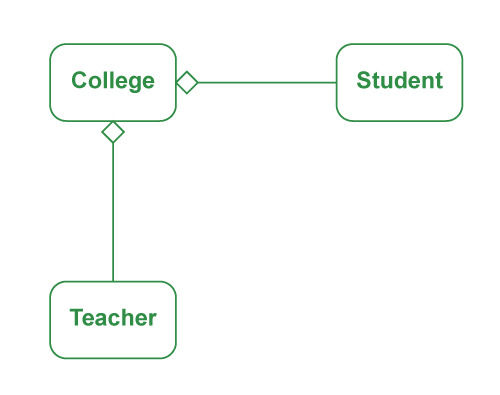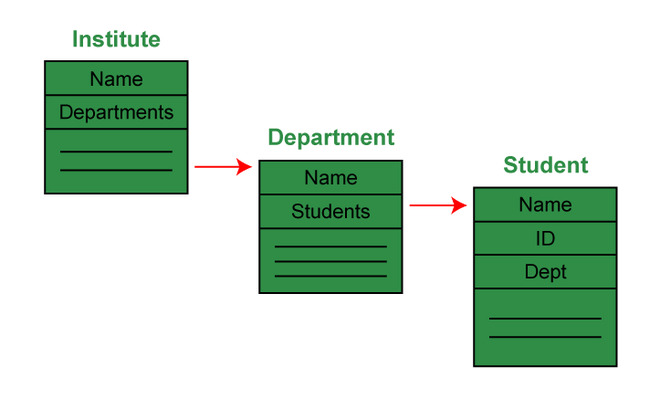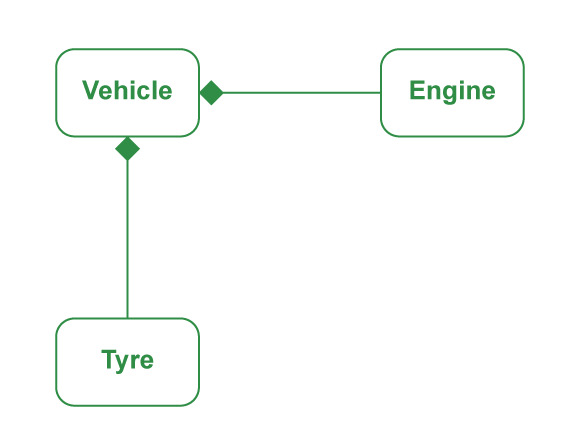聚合和組合說明了對象之間相互通信時的關係類型,這可以在低級設計中用於說明對象之間的關聯。在本文中,我們將討論 Java 編程語言中聚合和組合之間的差異。
Aggregation
它是一種特殊形式的協會,其中:
- 它代表Has-A的關係。
- 它是單向關聯,即one-way 關係。例如,一個係可以有學生,但反之亦然是不可能的,因此本質上是單向的。
- 在聚合中,兩個條目都可以單獨生存,這意味著結束一個實體不會影響另一個實體。

例子:
Java
// Java program to illustrate the
// Concept of Aggregation
// Importing required classes
import java.io.*;
import java.util.*;
// Class 1
// Student class
class Student {
// Attributes of student
String name;
int id;
String dept;
// Constructor of student class
Student(String name, int id, String dept)
{
// This keyword refers to current instance itself
this.name = name;
this.id = id;
this.dept = dept;
}
}
// Class 2
// Department class contains list of student objects
// It is associated with student class through its Objects
class Department {
// Attributes of Department class
String name;
private List<Student> students;
Department(String name, List<Student> students)
{
// this keyword refers to current instance itself
this.name = name;
this.students = students;
}
// Method of Department class
public List<Student> getStudents()
{
// Returning list of user defined type
// Student type
return students;
}
}
// Class 3
// Institute class contains list of Department
// Objects. It is associated with Department
// class through its Objects
class Institute {
// Attributes of Institute
String instituteName;
private List<Department> departments;
// Constructor of institute class
Institute(String instituteName,List<Department> departments)
{
// This keyword refers to current instance itself
this.instituteName = instituteName;
this.departments = departments;
}
// Method of Institute class
// Counting total students of all departments
// in a given institute
public int getTotalStudentsInInstitute()
{
int noOfStudents = 0;
List<Student> students;
for (Department dept : departments) {
students = dept.getStudents();
for (Student s : students) {
noOfStudents++;
}
}
return noOfStudents;
}
}
// Class 4
// main class
class GFG {
// main driver method
public static void main(String[] args)
{
// Creating object of Student class inside main()
Student s1 = new Student("Mia", 1, "CSE");
Student s2 = new Student("Priya", 2, "CSE");
Student s3 = new Student("John", 1, "EE");
Student s4 = new Student("Rahul", 2, "EE");
// Creating a List of CSE Students
List<Student> cse_students = new ArrayList<Student>();
// Adding CSE students
cse_students.add(s1);
cse_students.add(s2);
// Creating a List of EE Students
List<Student> ee_students
= new ArrayList<Student>();
// Adding EE students
ee_students.add(s3);
ee_students.add(s4);
// Creating objects of EE and CSE class inside
// main()
Department CSE = new Department("CSE", cse_students);
Department EE = new Department("EE", ee_students);
List<Department> departments = new ArrayList<Department>();
departments.add(CSE);
departments.add(EE);
// Lastly creating an instance of Institute
Institute institute = new Institute("BITS", departments);
// Display message for better readability
System.out.print("Total students in institute: ");
// Calling method to get total number of students
// in institute and printing on console
System.out.print(institute.getTotalStudentsInInstitute());
}
} 輸出:
Total students in institute: 4
輸出說明:在這個例子中,有一個研究所,有許多部門,如 CSE 和 EE。每個部門都沒有。學生的。因此,我們創建一個 Institute 類,它具有或不具有 Object 的引用。 Department 類的對象(即對象列表)。這意味著 Institute 類通過其對象與 Department 類關聯。 Department 類還引用了 Student 類的對象或對象(即對象列表),這意味著它通過其對象與 Student 類關聯。它代表Has-A 關係。在上麵的例子中:學生Has-A姓名。學生Has-A ID。學生 Has-A 部門 部門 Has-A 學生如以下媒體所示。

我們什麽時候使用聚合?
代碼重用最好通過聚合來實現。
作品
組合是聚合的一種受限形式,其中兩個實體彼此高度依賴。
- 它代表part-of關係。
- 在組合中,兩個實體相互依賴。
- 當兩個實體之間存在組合時,組合對象不能離開另一個實體而存在。

例子:
Java
// Java program to illustrate
// the concept of Composition
// Importing required classes
import java.io.*;
import java.util.*;
// Class 1
// Book
class Book {
// Attributes of book
public String title;
public String author;
// Constructor of Book class
Book(String title, String author)
{
// This keyword refers to current instance itself
this.title = title;
this.author = author;
}
}
// Class 2
class Library {
// Reference to refer to list of books
private final List<Book> books;
// Library class contains list of books
Library(List<Book> books)
{
// Referring to same book as
// this keyword refers to same instance itself
this.books = books;
}
// Method
// To get total number of books in library
public List<Book> getTotalBooksInLibrary()
{
return books;
}
}
// Class 3
// Main class
class GFG {
// Main driver method
public static void main(String[] args)
{
// Creating objects of Book class inside main()
// method Custom inputs
Book b1
= new Book("EffectiveJ Java", "Joshua Bloch");
Book b2
= new Book("Thinking in Java", "Bruce Eckel");
Book b3 = new Book("Java: The Complete Reference",
"Herbert Schildt");
// Creating the list which contains number of books
List<Book> books = new ArrayList<Book>();
// Adding books
// using add() method
books.add(b1);
books.add(b2);
books.add(b3);
Library library = new Library(books);
// Calling method to get total books in library
// and storing it in list of user0defined type -
// Books
List<Book> bks = library.getTotalBooksInLibrary();
// Iterating over books using for each loop
for (Book bk : bks) {
// Printing the title and author name of book on
// console
System.out.println("Title : " + bk.title
+ " and "
+ " Author : " + bk.author);
}
}
}輸出:
Title : EffectiveJ Java and Author : Joshua Bloch Title : Thinking in Java and Author : Bruce Eckel Title : Java: The Complete Reference and Author : Herbert Schildt
輸出說明:在上麵的示例中, Library 可以擁有許多相同或不同主題的書籍。因此,如果 Library 被摧毀,那麽該特定 Library 內的所有書籍都將被摧毀。也就是說,如果沒有 Library ,書籍就不可能存在。這就是為什麽它是組合。書是Part-of Library 。
Difference Between Aggregation and Composition in Java
|
聚合 |
作品 |
|---|---|
| 聚合可以說明為“Has-a”關係,表示對象之間的關聯。 | 組合意味著一個對象包含在另一個對象中。它是一種特殊類型的聚合(即Has-a關係),這意味著一個對象是另一個對象的所有者,這可以稱為所有權關聯。 |
| 對象之間存在相互依賴關係。 | 存在單向關係,這也稱為“part of”關係。 |
| 它是弱類型關聯,兩個對象都有自己獨立的生命周期。 | 它是強類型的關聯(聚合),子對象沒有自己的生命周期。 |
| 關聯對象可以獨立存在並有自己的生命周期。 | 孩子的生活取決於父母的生活。隻有父對象有獨立的生命周期。 |
| 白菱形的 UML 表示表示聚合。 | Black Diamond 的 UML 表示表示組合。 |
| 例如,學生和部門之間的關係。學生可能沒有院係而存在。 | 例如,一個文件包含在一個文件夾中,如果刪除該文件夾,裏麵的所有文件都會被刪除。如果沒有文件夾,文件就不能存在。 |
相關用法
- Java ArrayList add()用法及代碼示例
- Java ArrayList addAll()用法及代碼示例
- Java ArrayList clear()用法及代碼示例
- Java ArrayList clone()用法及代碼示例
- Java ArrayList contains()用法及代碼示例
- Java ArrayList get()用法及代碼示例
- Java ArrayList indexOf()用法及代碼示例
- Java ArrayList removeAll()用法及代碼示例
- Java ArrayList remove()用法及代碼示例
- Java ArrayList size()用法及代碼示例
- Java ArrayList isEmpty()用法及代碼示例
- Java ArrayList subList()用法及代碼示例
- Java ArrayList set()用法及代碼示例
- Java ArrayList sort()用法及代碼示例
- Java ArrayList toArray()用法及代碼示例
- Java ArrayList toString()用法及代碼示例
- Java ArrayList ensureCapacity()用法及代碼示例
- Java ArrayList lastIndexOf()用法及代碼示例
- Java ArrayList retainAll()用法及代碼示例
- Java ArrayList containsAll()用法及代碼示例
- Java ArrayList trimToSize()用法及代碼示例
- Java ArrayList removeRange()用法及代碼示例
- Java ArrayList replaceAll()用法及代碼示例
- Java ArrayList removeIf()用法及代碼示例
- Java ArrayList forEach()用法及代碼示例
注:本文由純淨天空篩選整理自thejavamentor大神的英文原創作品 Difference Between Aggregation and Composition in Java。非經特殊聲明,原始代碼版權歸原作者所有,本譯文未經允許或授權,請勿轉載或複製。
